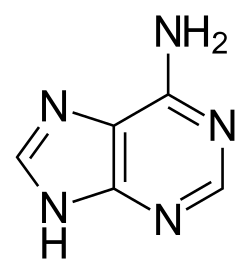adenine
English

Structure diagram of adenine
Etymology
From German Adenin, from Ancient Greek ἀδήν (adḗn, “gland”) + -ine.
Pronunciation
- IPA(key): /ˈæ.dəˌniːn/, /ˈæ.dɪˌnɪn/
Noun
adenine (countable and uncountable, plural adenines)
- (biochemistry, genetics) A base,
, found in certain glands and tissues, which pairs with thymine in DNA and uracil in RNA.
- 2006, David Markie, 1: Markers, Selection, and Media in Yeast Artificial Chromosome Cloning, Alasdair MacKenzie (editor), YAC Protocols, 2nd Edition, page 2,
- There are two genes in the adenine biosynthetic pathway of yeast (ADE1 and ADE2) that, apart from producing an absolute requirement for adenine when mutant, also produce a change in colony color.
- 2010, Debjani Roy, Rogué Schleyer, 6: Chemical Origin of Life: How do Five HCN Molecules Combine to form Adenine under Prebiotic and Interstellar Conditions, Chérif F. Matta, Quantum Biochemistry, page 202,
- The HCN pentamer, adenine (a constituent of DNA, RNA and many coenzymes), is one of the most abundant biochemical molecules.
Hypernyms
Related terms
Translations
base that pairs with thymine or uracil
Italian
This article is issued from
Wiktionary.
The text is licensed under Creative
Commons - Attribution - Sharealike.
Additional terms may apply for the media files.